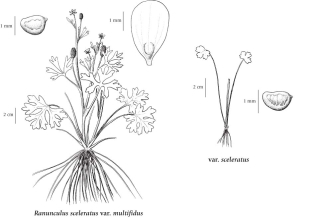Ranunculus sceleratus L.
celery-leaved buttercup (cursed buttercup; cursed crowfoot)
Ranunculaceae (Buttercup family)
Introduction to Vascular Plants
celery-leaved buttercup (cursed buttercup; cursed crowfoot)
Ranunculaceae (Buttercup family)
Introduction to Vascular Plants
Species Information click to expand contents
General:
Amphibious, annual herb, from slender, fleshy roots; stems 1 to several, erect, 15-50 cm tall, usually branched, smooth, hollow.
Leaves:
Basal and stem leaves kidney-shaped to semi-circular, deeply 3-lobed or 3-parted, 1-5 cm long, 1.5-7 cm wide, bases squared-off to heart-shaped, the segments again lobed or parted, sometimes undivided, margins round-toothed to -lobed, tips rounded or sometimes blunt, the stalks 2- to 4-times length of blade; stem leaves alternate, numerous, more deeply lobed and divided than basal leaves.
Flowers:
Inflorescence of few- to many-flowered cymes terminal to main stem and branches, the flower stalks stout, 1-3 cm long; receptacle hairy or smooth; petals 3-5, distinct, yellow, 2-5 mm long, 1-3 mm wide, egg-shaped, nectary on upper surface, the nectary scale about 1 mm long, not covering nectary; sepals 3-5, yellowish, bent back from near base, 2-5 mm long, 1-3 mm wide, smooth or sparsely stiff-hairy, early deciduous; stamens 15 to 20; pistils (50) 100-250 (or more).
Fruits:
Achenes, numerous in an elliptic to cylindric head 5-13 mm long, 3-7 mm wide, the achenes egg-shaped, slightly flattened, 1-1.2 mm long, 0.8-1 mm wide, thick-margined, smooth or corrugated; beaks stout, triangular, usually straight, 0.1 mm long.
Notes:
The introduced var. sceleratus, with more deeply cleft basal leaves and cross-corrugated achene faces, is known in the Osoyoos area.
Illustration click to expand contents

If more than one illustration is available for a species (e.g., separate illustrations were provided for two subspecies) then links to the separate images will be provided below. Note that individual subspecies or varietal illustrations are not always available.
Illustration Source: The Illustrated Flora of British Columbia
USDA Species Characteristics click to expand contents
Flower Colour:
Yellow
Blooming Period:
Late Spring
Fruit/Seed characteristics:
Colour: Brown
Present from Spring to Summer
Source: The USDA
Ecology click to expand contents
Ecological Framework for Ranunculus sceleratus
The table below shows the species-specific information calculated from
original data (BEC database) provided by the BC Ministry of Forests and Range.
(Updated August, 2013)
The table below shows the species-specific information calculated from
original data (BEC database) provided by the BC Ministry of Forests and Range.
(Updated August, 2013)
| Site Information |
Value / Class |
||
|
Avg |
Min |
Max |
|
| Elevation
(metres) |
1053 | 470 | 1665 |
| Slope
Gradient (%) |
8 | 0 | 60 |
|
Aspect (degrees) |
179 | 50 | 340 |
| Soil
Moisture Regime (SMR) [0 - very xeric; 4 - mesic; 8 - hydric] |
6 | 2 | 8 |
| Modal
Nutrient Regime
Class |
D | ||
| #
of field plots species was recorded in: |
34 | ||
| Modal
BEC Zone Class |
IDF | ||
|
All BEC Zones (# of stations/zone) species was recorded in |
BAFA(1), BG(2), BWBS(5), cma(1), ESSF(3), IDF(15), MS(1), SBPS(3), SBS(1), SWB(2) | ||
|
Source:
Klinkenberg 2013
|
|||
Habitat and Range click to expand contents
Wet to moist ponds, shores, mudflats and marshes in the lowland, steppe and montane zones; frequent in S BC east of the Coast-Cascade Mountains, infrequent elsewhere; N to AK, YT and NT, E to PQ and NB and S to LA, FL, MN, IA, NM, AZ and N CA.
Synonyms click to expand contents
Synonyms and Alternate Names:
Ranunculus sceleratus subsp. multifidus (Nutt.) Hultén